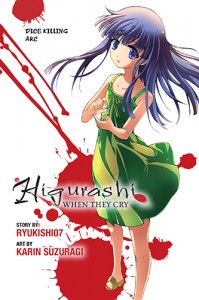Story by Ryukishi07; Art by Karin Suzuragi. Released in Japan as “Higurashi no Naku Koro ni: Saikoroshi-hen” by Square Enix, serialized in the magazine Gangan Joker. Released in North America by Yen Press.
As the readers of Higurashi plowed their way through the series, they gradually began to notice that the protagonist was changing before their eyes. At the start, this looked like a typical datesim variant, albeit a dark one, and therefore Keiichi Maebara was clearly the hero. After all, in the visual novels he didn’t even have a sprite. But as we got deeper into the plot, we realized who was really the driving forced behind this: Rika Furude, the young shrine maiden who was the only person who could remember all the past worlds. Indeed, she seemed at times to be much older than her unstated tween age, having lived her life till getting killed June 1983 over and over again. The main series, being more concerned with figuring out why this was happening and how to stop it, rarely stopped to consider the psychological implications of this. This epilogue, the “Dice-Killing Arc”, is here to do that.
The basic premise is simple enough: Rika, who is no longer threatened by impending death, becomes too careless when biking down a seldom-used hill and is struck by a truck. She wakes up in a world unlike all the others she’d been reliving over and over again. Keiichi isn’t here, Satoshi is alive, and so are her parents. In this new world, all the horrible things that happened in everyone’s pasts seem to have been avoided. It’s a “sinless world”… but is there a place for Rika in it? Can she return to the Higurashi world we know and love? And who is Rika Furude anyway?
As Ryukishi07 wrote this, he was also writing and planning his next series, Umineko: When They Cry, so it’s unsurprising that elements of that are seen in this. Most obvious is Rika feeling disassociated with her child self – she’s lived so many lives by now that she doesn’t feel like Rika Furude anymore, and when she makes the transition into this world she feels like she’s possessed the real Rika Furude. In a drunken stupor (we’ve seen Rika dilute wine and get drunk on it before, and she does here as well – be warned) she stares at the label on her father’s wine bottle and declares that her alternate self is actually Frederica Bernkastel.
As if this wasn’t disturbing enough, Rika’s mental state really takes a nosedive in this world. Satoko supposedly hates her and the others are mostly indifferent to her. Her parents are alive, but this doesn’t cheer her up – she simply regards them as nuisances. It all comes to a head when she’s sitting in class trying to work out how to return to her own world and Satoko decides to bully her a little too much – she snaps and punched Satoko, then starts to beat her over and over with a chair. “Fans” of Higurashi who saw this in the anime tended to be a little too happy over this scene, feeling Satoko “got what she deserved”. First of all, if you feel anyone in Higurashi gets what they deserved, stop following the series. Secondly, this scene is meant to be HORRIBLE. It’s preceded by a scene where Hanyuu (communicating with Rika via a relic) states that she may have to kill someone to get back to her world, and Rika hopes it’s her parents, as she has no attachment to them. It’s truly chilling.
What ends up happening, thankfully, is that Rika slowly understands this isn’t just her correct world and a “wrong” world, but two unique worlds with their own virtues. She starts to rebuild a relationship with her mother, who had always been upset at Rika seemingly knowing how to do things (due to the loops) and showing little affection; Rika also tries to remember what being a child who loves her parents was like in the first place. Likewise, Satoshi, Reina and the others help her to realize she can forge new bonds here, and maybe try to be friends with Satoko again. In the end, Rika makes the decision to stay in this world and not kill her mother…
A decision that turns out to perhaps be irrelevant, as she wakes up (after being in a coma for a month) back in the Higurashi world we know and love, with everything seemingly having been a “dream”. This ending is somewhat debated in Higurashi fandom, mostly as it’s implied it was a dream Hanyuu deliberately forced on Rika in order to get her to properly remember and grieve for her parents (and also possibly remind her not to bike into traffic). This would probably read better if Hanyuu had been better characterized throughout the series – we’re not even sure why she’s incorporeal again.
So not without its faults – there’s also a long expodump between Reina (who kept the i in this world) and Rika explaining the differences that’s almost painful – but it’s a story I’m happy we got, as it reminds us that even if there is a happy ending for everyone, lives still go on, and Rika has to make the decision to go forward at last, and not let herself be bound by her repeated loops and assumptions. I’m not sure if we’ll see more Higurashi manga after this (Daybreak and Bus Stop are still out there if Yen is interested), but as epilogues go, this is a fitting ending for the series.


Speak Your Mind